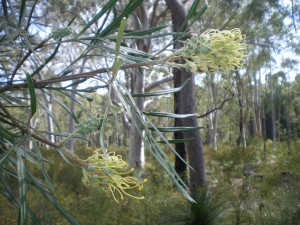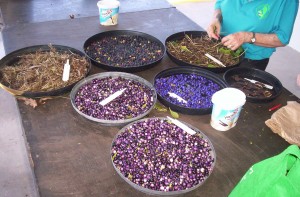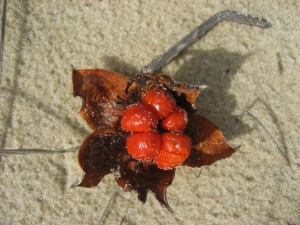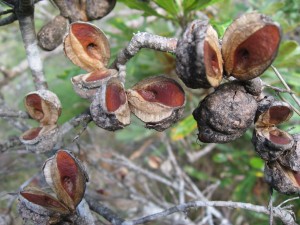
Every plant grown at Coolum Community Native Nursery is a “local native”, meaning it naturally occurs on the Sunshine Coast. We do not grow plants from other parts of Australia, for example Grevilleas, of which the most popular garden variety species are almost all from Western Australia. Grevilleas, along with Umbrella Trees from North Queensland, escape into natural bushland near backyards and compete with local native plants. They also change the population dynamics of local birds by oversupplying certain bird species with food, to the detriment of other birds.
All seed and cuttings are collected by our volunteers and staff on the Sunshine Coast to guarantee local genetic characteristics. In every case we try to collect from a large number of individual plants naturally occurring in the wild. This is possible in approximately 90-95% of cases, the remainder of which are collect from cultivated plants on public and private lands. There are also a handful of species we cultivate by division within the nursery facility (i.e. groundcover species). Very rarely, for species that can’t seem to be grown from seed or cutting, we collect quantities of “wildlings”, baby plants naturally occurring en masse after a bushfire event or a particularly heavy seeding. This is only done if it will not endanger the natural reproductive lifecycle of the species at a particular location.

One of our biggest challenges is finding sufficient quantities of wild-sourced seed that is not occurring in National Parks (no plant matter is to be taken from Queensland National Parks unless it is written into a specific species recovery program). We hold special permits from both DERM (Department of Environment and Resource Management) and SCC (Sunshine Coast Council) to undertake seed and propogule collection (“propogules” include cuttings and parts of plants cultivated by division) on specified public lands. We are always searching for new and better populations of plants available to collect seeds from. It is not recommended for individuals to collect seeds in the wild without written permission from the landowner.
Our regular collection range extends from Noosa North Shore, to Currimundi Lake at Caloundra, and west to Mt Ninderry at Yandina. Occassionally some of our enthusiastic customers, volunteers, and staff collect seed on their own properties that they have naturally occurring, or have planted previously. This extra seed source comes from as far as Maleny, Landsborough, and Pomona, and is always a welcome addition to our seed bank.
Seed is cleaned as quickly as possible and either sown fresh or stored in our seed bank. Perishable seed must be sown immediately to ensure good germination rates, but many species occurring in Eucalyptus forests and Wallum heathlands have excellent storage capabilities, which allow a steadier propagation regime. Perishable seed, often from rainforests, can be germinated and then allowed to sit for long periods in propagation trays without fertilisers, until required to prick-out into tubes.

